The Siberian husky is a medium-sized working dog from northeastern Asia. These dogs are commonly referred to as huskies, Sibes, and husky Sibes.
Huskies grow up to 23.5 inches tall and are known for their stubborn, vocal attitudes, and wolf-like appearance.
Siberian huskies are affectionate and get along well with children and other dogs. These dogs have a lot of energy and need plenty of exercise to stay fit and happy.
They typically cost between $700 and $1,300.
TABLE OF CONTENTS
Siberian Husky Characteristics & Overview
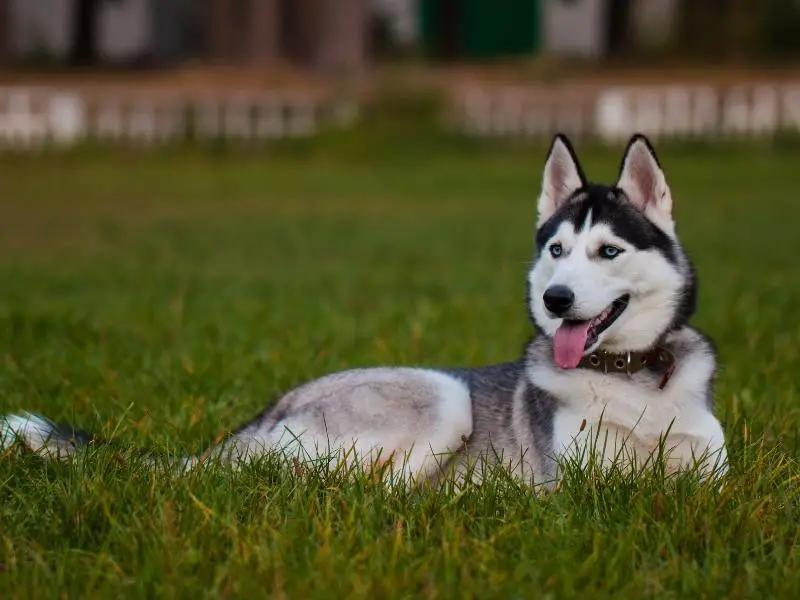
| Common names: | Siberian husky, husky, husky Sibe |
| Origin: | Northeastern Asia, Siberia |
| Breed group: | Working dog |
| Size: | Medium |
| Height: | 20–23.5 inches |
| Weight: | 35–60 pounds |
| Colors: | Black, white, sable, brown, tan, agouti, gray |
| Coat: | Thick, medium-length double coat |
| Life expectancy: | 12–14 years |
| Temperament: | Loyal, sociable, playful, independent, stubborn, affectionate |
| Shedding: | Regular with seasonal undercoat shedding |
| Barking tendency: | Minimal, with frequent howling or whining |
| Cost: | $700–$1300 |
Origin & Purpose
The Siberian husky is a Spitz breed originally bred as a companion and working sled dog. The breed was first developed by the Chukchi people of Siberia, who wanted to create a strong and reliable sled dog capable of enduring vast distances in Arctic temperatures.
In the early 20th century, Siberian huskies were imported to Alaska and the American Kennel Club (AKC) officially recognized the breed in 1930.
Lifespan
The average life expectancy of Siberian huskies is 12 to 14 years. Factors that impact their life expectancy include genetics, exercise, diet, and healthcare.
Siberian Husky Appearance
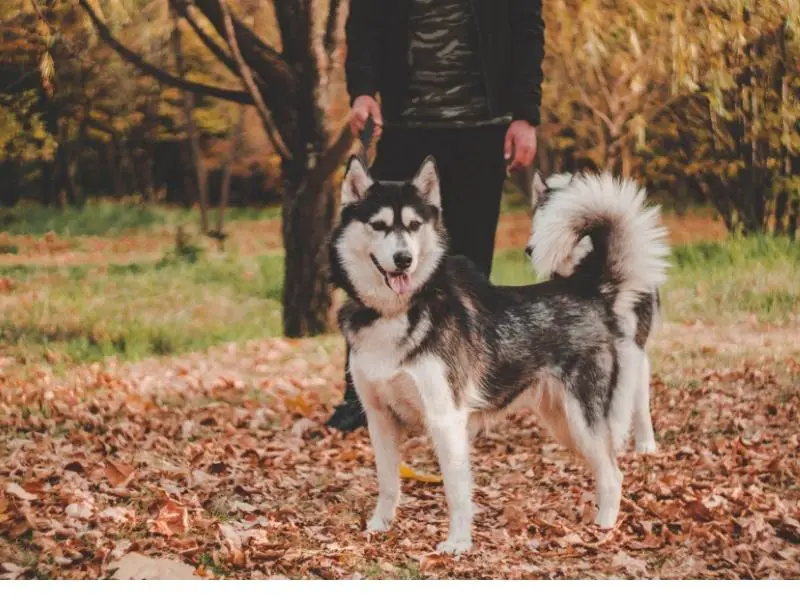
The Siberian husky is a medium-sized breed with a thick double coat and compact build. Siberian huskies resemble wolves, with erect ears, striking eyes, brush tails, and a variety of coat-color combinations.
Height and Weight
Growing 20 to 23.5 inches at the withers and 35 to 60 pounds, the Siberian husky is considered medium-sized. Males weigh more than females and are 1 to 3.5 inches taller.
An eight-week-old husky puppy weighs 8 to 15 pounds and grows up to 12 inches. They reach their full-grown size within 12 to 15 months.
Colors
The color of Siberian huskies can range in intensity and shades, but the most common colors are gray, black, or brown with white markings.
The most well-known color combination is white and black, while the rarest coat color is pure white.
Coat
Siberian huskies have medium-length double coats. Their undercoats are dense with short, thick hair, while their outer coats are made up of long, straight guard hairs that repel water and shield the dog from dirt and debris.
Huskies typically have dark backs, white bellies, and dark facial markings which spread up to the ears.
The undercoat of these dogs blows out twice a year, on average, depending on the climate. In warm environments, this breed sheds its coat moderately throughout the year.
Head and Facial Features
The Siberian husky has an arched neck, a medium-sized muzzle, and almond-shaped eyes that are either brown or blue. Some huskies have heterochromia iridum, which means their eyes are two different colors or are multi-colored.
This breed has high-set, triangular ears and noses that are black, liver, or flesh-colored.
Personality and Temperament
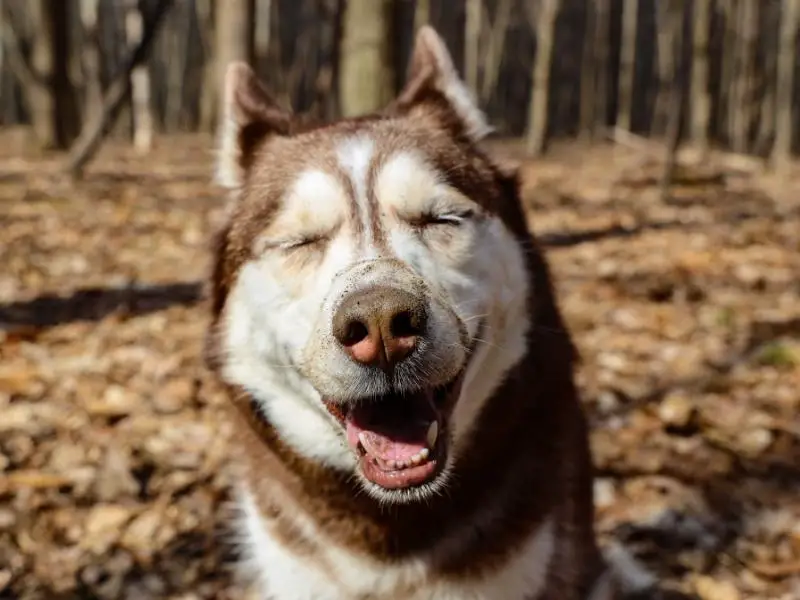
According to the AKC’S breed standard, Siberian huskies are friendly, outgoing, and gentle.
People who lead an active lifestyle are best-suited to own huskies because the breed is energetic and needs plenty of exercise.
These dogs get along well with children and other dogs, making them ideal family pets. However, huskies are famous for being stubborn and need experienced owners that can be firm and patient.
Because of a high prey-drive and restless nature, huskies should be supervised at all times, as they are likely to escape or chase after small animals.
Barking
Siberian huskies rarely bark, preferring to howl or whine to express themselves. This may make them unsuitable for apartment living, as their howls are loud and often disturb neighbors.
Siberian Husky Care
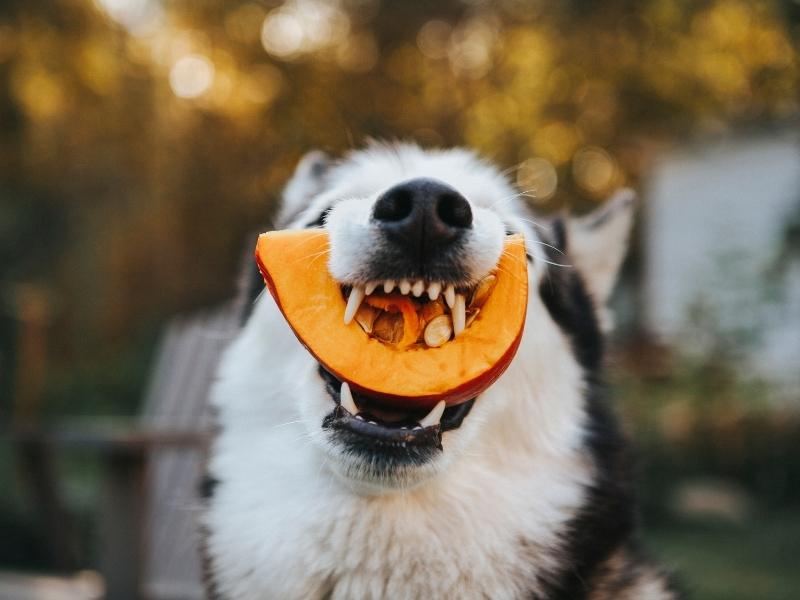
Caring for a Siberian husky is difficult because of the dogs’ demanding lifestyle and stubborn attitude. Without appropriate care, huskies often become destructive and engage in unwanted behaviors, such as chewing and scratching.
With the right owner and training, these dogs make wonderful and affectionate companions.
Food Needs
A mature Siberian husky should be fed two cups of high-quality, nutrient-rich dog food that is made for medium-sized dogs and is split across two meals each day. The amount varies depending on size, sex, and activity level.
Husky puppies should be fed three to four cups of food daily split across three meals, reducing to two cups once they’re eight months old.
Grooming Needs
Siberian huskies are easy to groom because they practice self-cleaning and don’t require regular bathing because their coat doesn’t hold odors easily.
Brushing these dogs weekly will remove trapped hair, make the coat tangle-free, and keep skin healthy. Regular brushing during heavy shedding will help remove trapped excess undercoat hairs.
Nails must be kept short and trimmed if necessary.
Exercise Needs
As Siberian huskies are playful and have an endless amount of stamina, they need at least two hours of vigorous exercise per day, preferably split into two separate walks.
These dogs should also be given ample opportunities to run around as this helps them burn off excess energy.
They can live in apartments as long as their exercise needs are met and they are provided with lots of playtime. Some huskies may struggle when adapting to small areas, especially if they’re used to spacious environments.
Mental Needs
The Siberian husky requires a lot of mental stimulation — at least 60 minutes spread out across the day — to prevent it from becoming bored and restless. Left alone, these dogs will find their own ways to curb boredom and may engage in destructive behavior.
Interactive games such as fetch and tug-of-war help them get rid of excess energy while strengthening family bonds. Puzzle toys are a good option as they keep the dogs’ brains engaged for long periods of time.
Common Health Concerns
Siberian huskies are a relatively healthy breed, but common issues that affect them include:
- Hip dysplasia: Occurs when the hip joint hasn’t developed properly and can lead to arthritis and lameness.
- Hypothyroidism: A condition that increases the dog’s metabolic rate to a harmful level, causing weight loss, anxiety, and diarrhea.
- Progressive retinal atrophy (PRA): An inherited condition that causes progressive blindness. There is currently no known treatment for PRA, but it can be screened for.
- Cataracts: Cataracts obscure vision and can lead to blindness. Cataracts can be treated with surgery.
- Glaucoma: An eye condition where the optic nerve becomes damaged, leading to eye pain, a watery discharge, bulging of the eyeball, and blindness. Glaucoma can be managed and treated with medication and, in severe cases, surgery.
- Corneal dystrophy: An inherited progressive disease that affects the cornea of the eye and causes cloudiness. Corneal dystrophy is treated with dietary changes, eye drops, and surgery.
Reputable breeders screen and test for inherited conditions like PRA. Avoid breeders that won’t provide the parent’s health certificates and records.
Training
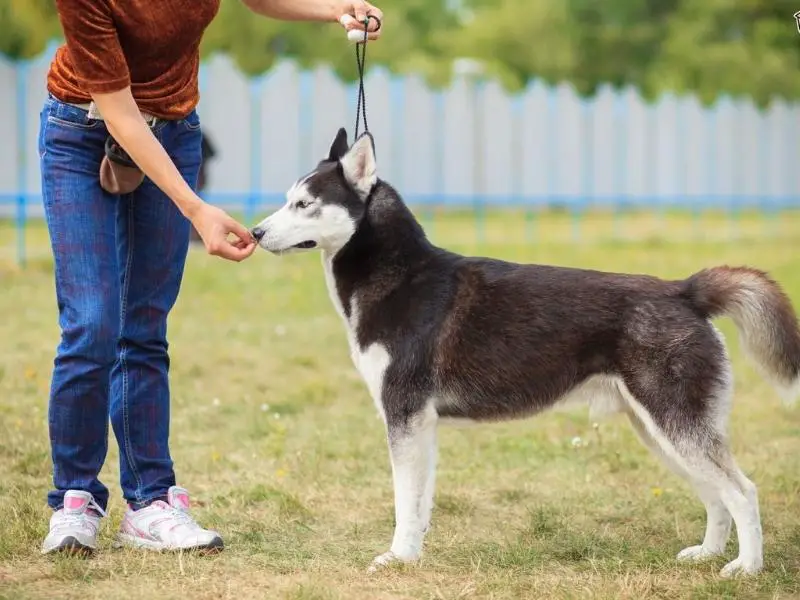
Siberian huskies are intelligent dogs, but their stubborn and independent nature makes them difficult to train. Therefore, a persistent, patient, and firm training approach is necessary.
Training sessions should be kept short, and the use of high-value rewards like chicken or cheese will keep these dogs motivated.
Positive reinforcement-based methods are more effective, because punishments cause fear and stress which can lead dogs to become aggressive.
Socialization and training should begin from an early age, as Siberian husky puppies are more receptive to new things than adults.
Start with house training, leash training, and basic obedience training. Important commands to teach a husky puppy are sit, stay, come, and lie down.
Siberian Husky Price
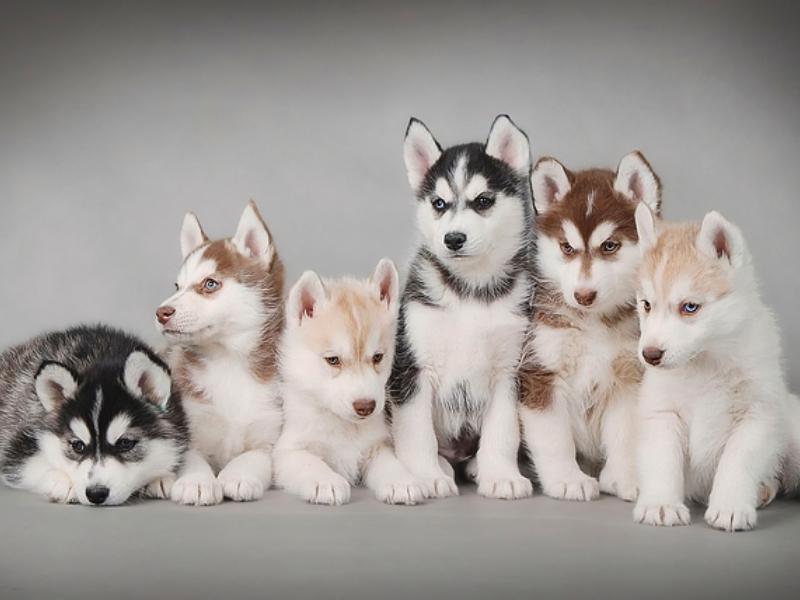
Siberian huskies are relatively expensive dogs because there is high demand for this breed. The initial cost depends on the dog’s age, bloodline, and if the dog is adopted or purchased from a breeder.
Older dogs and rescues are much cheaper than purebred huskies or puppies.
How Much Is a Siberian Husky?
A Siberian husky typically costs between $700 and $1,300. Show dogs cost $3,000 or more. Factors that affect pricing include the dog’s age, coat color, eye color, and lineage.
Adult huskies are cheaper than puppies and typically cost around $600. Adopting this breed is much cheaper. However, it can be difficult to find huskies in shelters due to the high demand for the breed.
How Much Does it Cost to Own a Siberian Husky?
The monthly cost of owning a Siberian husky is $115 to $160 per month, which includes necessities such as food, toys, grooming supplies, medical expenses, and treats.
First-year expenditures are higher than subsequent years due to initial costs such as beds, walking equipment, and collars. Expect to pay around $2,500 to $3,500 in the first year, and $1,300 or $2,000 in subsequent years.
Is This Breed Right for You?
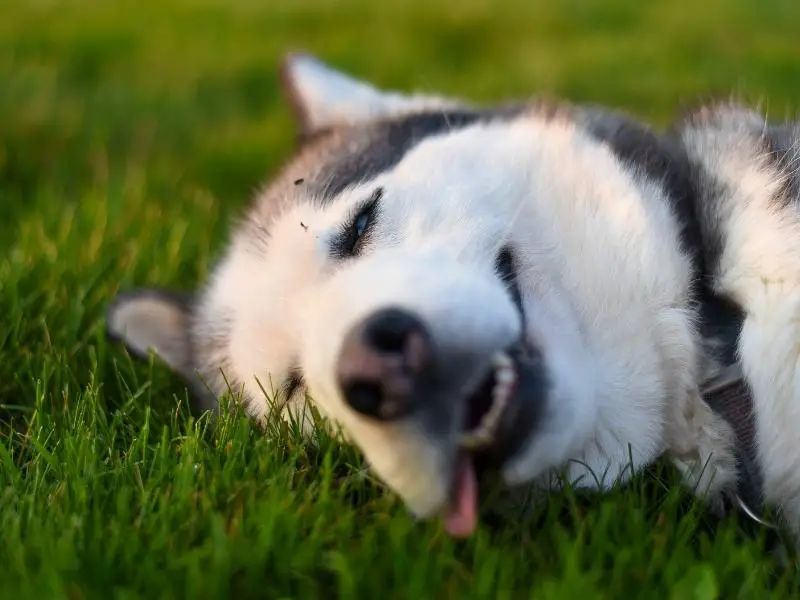
Siberian huskies are affectionate, playful, and sociable dogs. However, the breed’s stubborn and energetic nature means they aren’t suitable for some people and lifestyles.
Huskies need an active, experienced dog owner who can spend most of the day with them.
Who Should Get a Siberian Husky?
Siberian huskies are ideal for individuals who lead an active lifestyle and can dedicate plenty of time to care and training. These dogs thrive with an experienced owner that can work with their stubborn nature without getting frustrated.
Affectionate and gentle, these dogs make wonderful companions for families with kids. A household with a large, secure yard is perfect for huskies that need plenty of space to run around and help them release excess energy.
Who Should Not Get a Siberian Husky?
Huskies need a lot of exercise, can get bored easily, and shouldn’t be left alone for long periods of time. Therefore, these dogs aren’t compatible with people who spend most of the day away at work, rarely exercise, or have mobility issues.
First-time dog owners should avoid this breed as these dogs are difficult to train without experience.
Individuals who live in thin-walled apartments or dense community areas should be aware that huskies are loud, vocal dogs, which can lead to noise complaints.
Siberian Husky Mixes
Siberian huskies have been crossbred to create some beautiful and unique designer dog hybrids. If you like huskies, you may be interested in some of the following mixes:

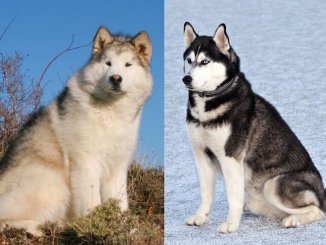
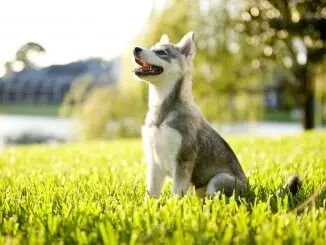
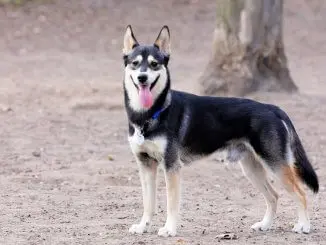
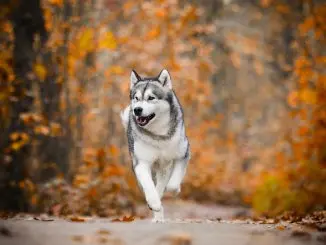
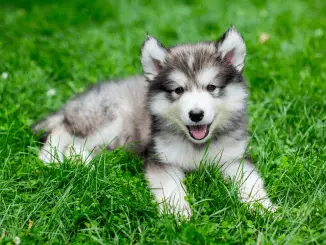
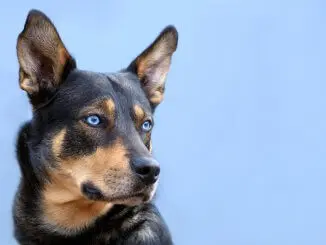
I have 2 Siberian dogs. Rescues from 5 mo pups a boy & a girl. 2 dogs keep them busy with each other & exercised. A lot of work so make sure you read about these pups. They are not Couch potatoes. Great info on here!!!!!!!